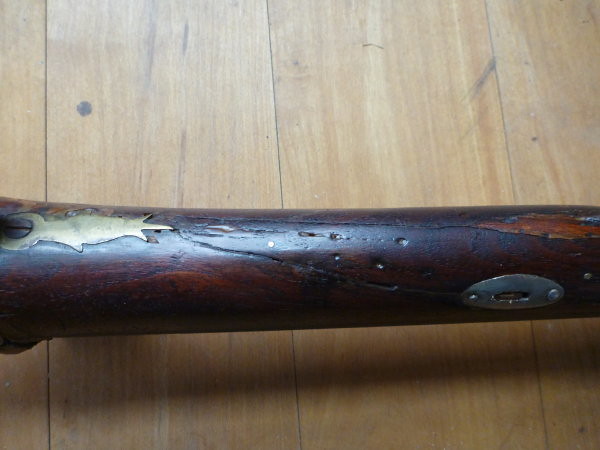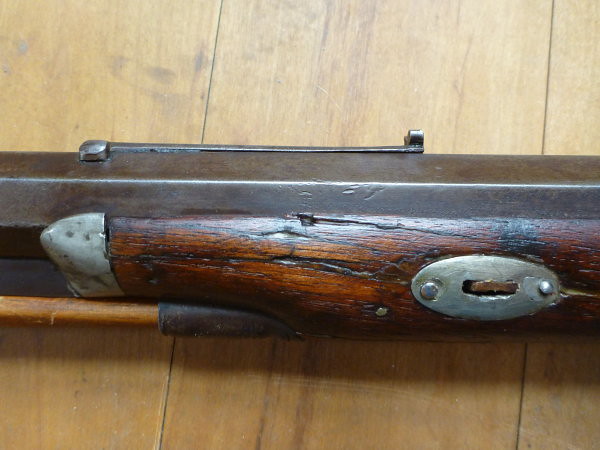Afternoon gents, as the topic implies, I'm trying to gather some information pertaining to how smiths made their repairs mainly to cracked stocks. My curiosity is sparked because I'm in the process of repairing one such crack on my 1857 ohio halfstock rifle. I wanted to approach the repair in a period correct nature. My particular issue will require pinning with a brass rod or dowel... Again I'd like to make this repair period correct but my venture in searching has came up empty handed. :hatsoff:
-
This community needs YOUR help today. We rely 100% on Supporting Memberships to fund our efforts. With the ever increasing fees of everything, we need help. We need more Supporting Members, today. Please invest back into this community. I will ship a few decals too in addition to all the account perks you get.

Sign up here: https://www.muzzleloadingforum.com/account/upgrades -
Friends, our 2nd Amendment rights are always under attack and the NRA has been a constant for decades in helping fight that fight.
We have partnered with the NRA to offer you a discount on membership and Muzzleloading Forum gets a small percentage too of each membership, so you are supporting both the NRA and us.
Use this link to sign up please; https://membership.nra.org/recruiters/join/XR045103
You are using an out of date browser. It may not display this or other websites correctly.
You should upgrade or use an alternative browser.
You should upgrade or use an alternative browser.
Early stock repairs?
- Thread starter Crewdawg445
- Start date

Help Support Muzzleloading Forum:
This site may earn a commission from merchant affiliate
links, including eBay, Amazon, and others.
It would help if you would post pictures of your rifle with good shot's of the cracked area. IMO, repairs made back in the day were not always the best. Having our 21st century technology at your disposal to fix a cracked stock where it will not show like a sore thumb. I am not condemning the old smith's or gun owners from the past, as they did their best to keep a rifle up and shooting. Many repairs were made with brass or copper plates screwed around a crack or break. Many of these repairs have held up to modern times and actually give an old gun the story of it's history. To copy this type of repair today would not add ANYTHING to your rifle! Especially not to it's value. There are craftsmen around today who could fix the cracks in a stock and make the fix nearly invisible and stronger than before it was damaged. Hope this has been some help to you Crewdawg.
Black Hand
Cannon
- Joined
- Mar 17, 2005
- Messages
- 9,348
- Reaction score
- 893
Rawhide and brass wire were not uncommon, but may depend on your location and time.
Agreed with the pictures, I'm currently not able to but will later on for reference.
Again I'd like to make this repair period correct
Can't criticize that objective. But, do consider changing to 'I'd like to make this repair appear period correct...'.
Really, don't sacrifice a good fix just for looks sake. I suggest pins or dowels. I have had good luck with brazing rod run through a threading die then glued into place and sanded smooth on the surface. Those pins showing where the fix was don't bother me a bit. To me, they are just part of the story of the life of the rifle. But, you can put rawhide over the spot to suit yerself.
- Joined
- Jan 9, 2008
- Messages
- 1,893
- Reaction score
- 2,092
I had to make a broken stock repair to one of my home built flintlock rifles. To be sure of a good bond between the two pieces, I used a good epoxy (gasp), then wrapped some sheet brass completely around the wrist. This covers most of the crack and definitely makes it unique.
The repair was made over 30 years ago and the stock is still in one piece.
The repair was made over 30 years ago and the stock is still in one piece.
- Joined
- May 6, 2014
- Messages
- 16,892
- Reaction score
- 15,307
Back in 1980, I not only cracked/broke the wrist of my NA Brown Bess Carbine, but shattered pieces of the stock off from the wrist. The minute I heard the stock break, I was heartsick. (I had made the mistake of inadvertently using the buttstock to "break my fall" when I went down into a prone position as I had been trained in the modern military.) Since I had begun doing WBTS reenacting, that Bess stayed in that condition until "I could get around to fixing it." What I did not realize at the time, that Bess would stay that way for almost 20 years before I came back to reenacting the 18th century.
As others suggested, I used two pieces of threaded brass rod and drilled holes in the stock ahead of and behind the crack/busted out parts so that the rods would not show through after the repair was done. I had also learned to colour Brownell's Accraglas to come very close to the colour of the wood. I also found that to get the broken out pieces of wood to fit, I had to actually finish breaking the butt section off the stock. (That was the scariest part of the repair.)
When I "reglued' the pieces of the stock and wrist back together, I was fortunate that rear of the triggerguard and thumbpiece with screw pretty much aligned everything back together. (I did mold release the metal parts so I could get them out of the stock later.) I applied further pressure to hold the broken out pieces of the wrist by wrapping the wrist with surgical tubing. Then I waited with much consternation while the repair cured.
To my delight, I found there were only the tiniest traces of Accraglas that showed through, after I cleaned the stock up. I used a tiny point black permanent magic marker to continue the grain of the wood through the traces of Accraglass that still showed. Then I stained the stock lightly. At that point, I thought about making a sheet copper wrap to go around the wrist, but decided to wait and see what it looked like after I refinished the stock. Much to my relief, I found it was VERY difficult for even me to spot where the repairs had been made and I was the one who did it. (I showed that gun to many others and none of them spotted the repair until after I mentioned it and I had to actually point out where it was done to most people.)
At that point, I decided to put off making a sheet brass wrap to go around the repaired portion of the wrist and stock. If I could not easily see it and most others could not see it, I figured I could live with it that way. However, if the repair had been more noticeable or had it really bugged me, I would have done the "authentic repair" of wrapping sheet brass around it and tacking it in place "just for show."
Gus
As others suggested, I used two pieces of threaded brass rod and drilled holes in the stock ahead of and behind the crack/busted out parts so that the rods would not show through after the repair was done. I had also learned to colour Brownell's Accraglas to come very close to the colour of the wood. I also found that to get the broken out pieces of wood to fit, I had to actually finish breaking the butt section off the stock. (That was the scariest part of the repair.)
When I "reglued' the pieces of the stock and wrist back together, I was fortunate that rear of the triggerguard and thumbpiece with screw pretty much aligned everything back together. (I did mold release the metal parts so I could get them out of the stock later.) I applied further pressure to hold the broken out pieces of the wrist by wrapping the wrist with surgical tubing. Then I waited with much consternation while the repair cured.
To my delight, I found there were only the tiniest traces of Accraglas that showed through, after I cleaned the stock up. I used a tiny point black permanent magic marker to continue the grain of the wood through the traces of Accraglass that still showed. Then I stained the stock lightly. At that point, I thought about making a sheet copper wrap to go around the wrist, but decided to wait and see what it looked like after I refinished the stock. Much to my relief, I found it was VERY difficult for even me to spot where the repairs had been made and I was the one who did it. (I showed that gun to many others and none of them spotted the repair until after I mentioned it and I had to actually point out where it was done to most people.)
At that point, I decided to put off making a sheet brass wrap to go around the repaired portion of the wrist and stock. If I could not easily see it and most others could not see it, I figured I could live with it that way. However, if the repair had been more noticeable or had it really bugged me, I would have done the "authentic repair" of wrapping sheet brass around it and tacking it in place "just for show."
Gus
Your post is well said. :thumbsup:
ohio ramrod
75 Cal.
- Joined
- Aug 21, 2008
- Messages
- 7,473
- Reaction score
- 2,202
Field repairs were usually rawhide and tacks/wire. Many gunsmith repairs were brass "wraps" or even even iron strips inlay. :idunno:
Is this a copy of an 1857 or an original? As its value would affected by a repair. I don't own any originals, and would not own a gun I couldn't shoot. I would do a repair to make it useable and not care about a change in market value for me. However it would be something you have to keep in mind.
Back in the 80s we took a cva Mountian ride and Brock it at the wrist on purpose. Then effected a repair with homemade glue and deer skin rawhide that works real well.
Back in the 80s we took a cva Mountian ride and Brock it at the wrist on purpose. Then effected a repair with homemade glue and deer skin rawhide that works real well.
No it's not a copy, but indeed an original 1857 ohio halfstock made by J Hefner of Marion OH. I'm not worried about value, yet let me be careful when I toss that around... What the rifle means to me as a whole is far more important than what someone would be willing to pay or it's overall resale value as it will never be for sale. However what I'm doing with the rifle is restoring it in a way that will not hurt what value it has and as you mentioned, be a 100% Shootable. We hear and see time and time again of people defacing an antique arm by doing what they think is refinishing, but in reality it's the exact opposite. By no means do I plan on that happening with this rifle so with the stock repair I'm wanting to gather as much information as possible before pressing on with a permanent repair. There are some things with this rifle and it's age I wouldn't attempt. The bridle, tumbler and sear within the lock were worn. I have since surrendered the lock and barrel to my good friend who is a smith by trade and who does fantastic work. We have decided the the original components can be fixed and will be doing so within a few weeks. With the barrel being a .40 caliber smoothie, I'll be having him re-bore to a .45. As you can imagine with its age the bore is rather nasty, yet upon scoping the entire length from the muzzle to the breech all has been cleared and rendered safe for shooting after the re-bore. Now back to the stock... sorry I got a little  ff there!
ff there!
Here's a photo of the crack I'm wanting to repair.
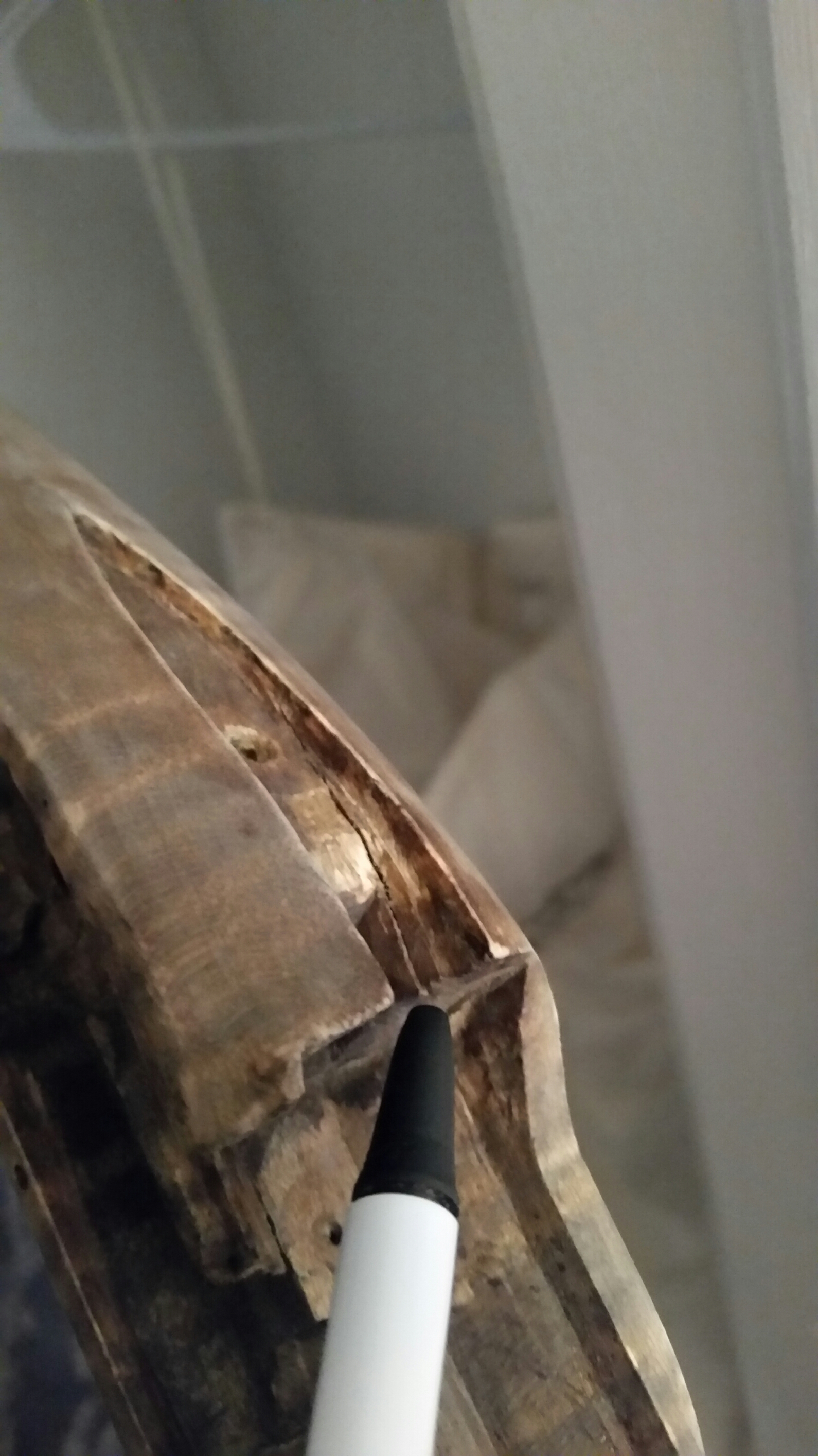
Notice my pen point obviously points to the crack extending to the rear of the tang channel. This can be fixed in two ways upon inspection.
1. Through the lock panel and drilled up.
2. From the top left outside portion of the stock drilled down.
For me, trying to hide the repair is something I'm not concerned about, I personally believe this displays character.
Also here are a few pictures of the stock after I stripped and cleaned the wood, It was absolutely filthy! As of now the stock is hanging in a spare closet to dry. Someone along the way certainly applied something overtop of the original finish. Whatever it was age had set in and it was beginning to crack in multiple areas. I will be using BLSO followed by applications of Truoil once I've decided on a stain and that part is complete. As it sits, I personally feel the wood is beautiful.
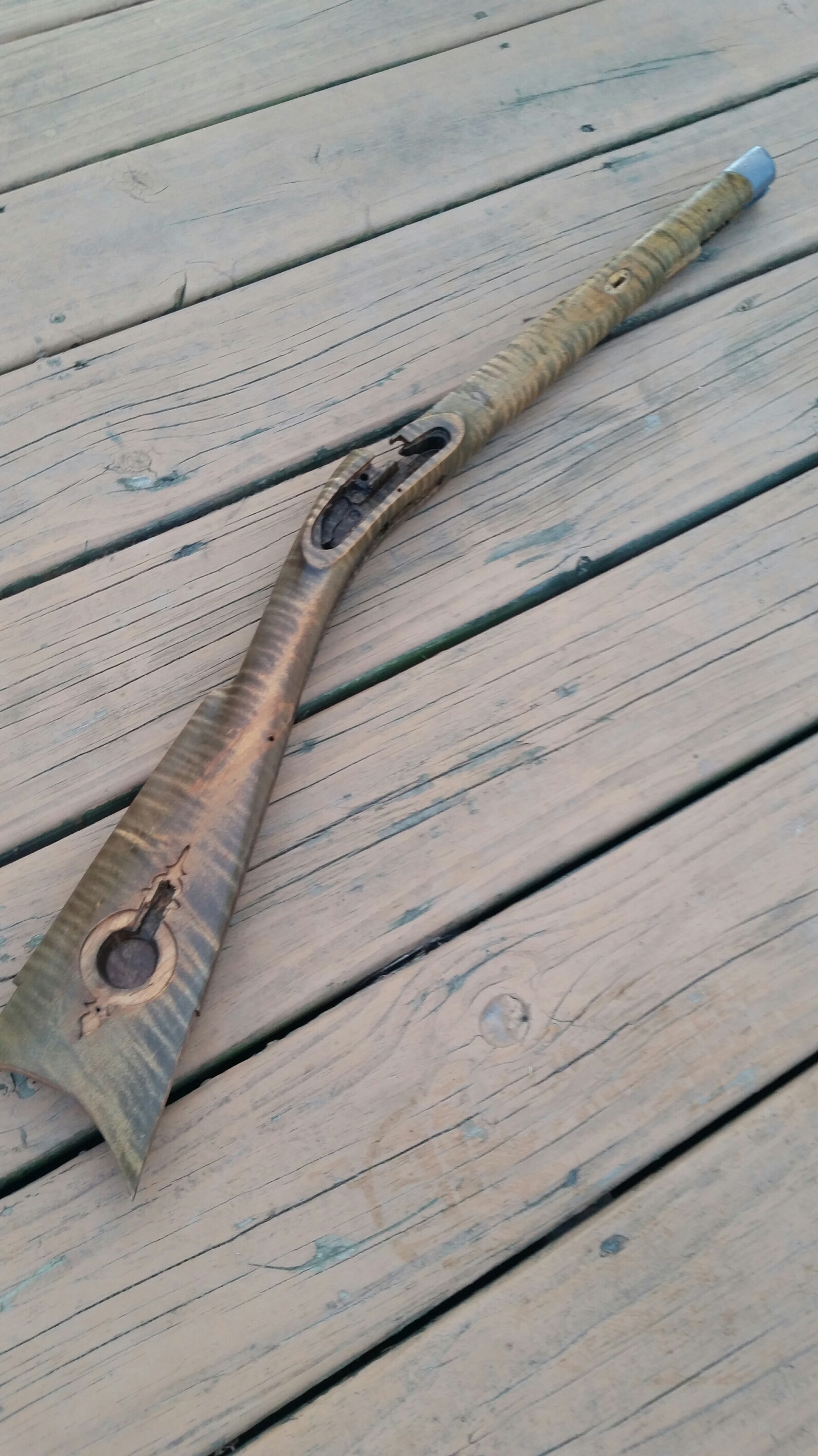
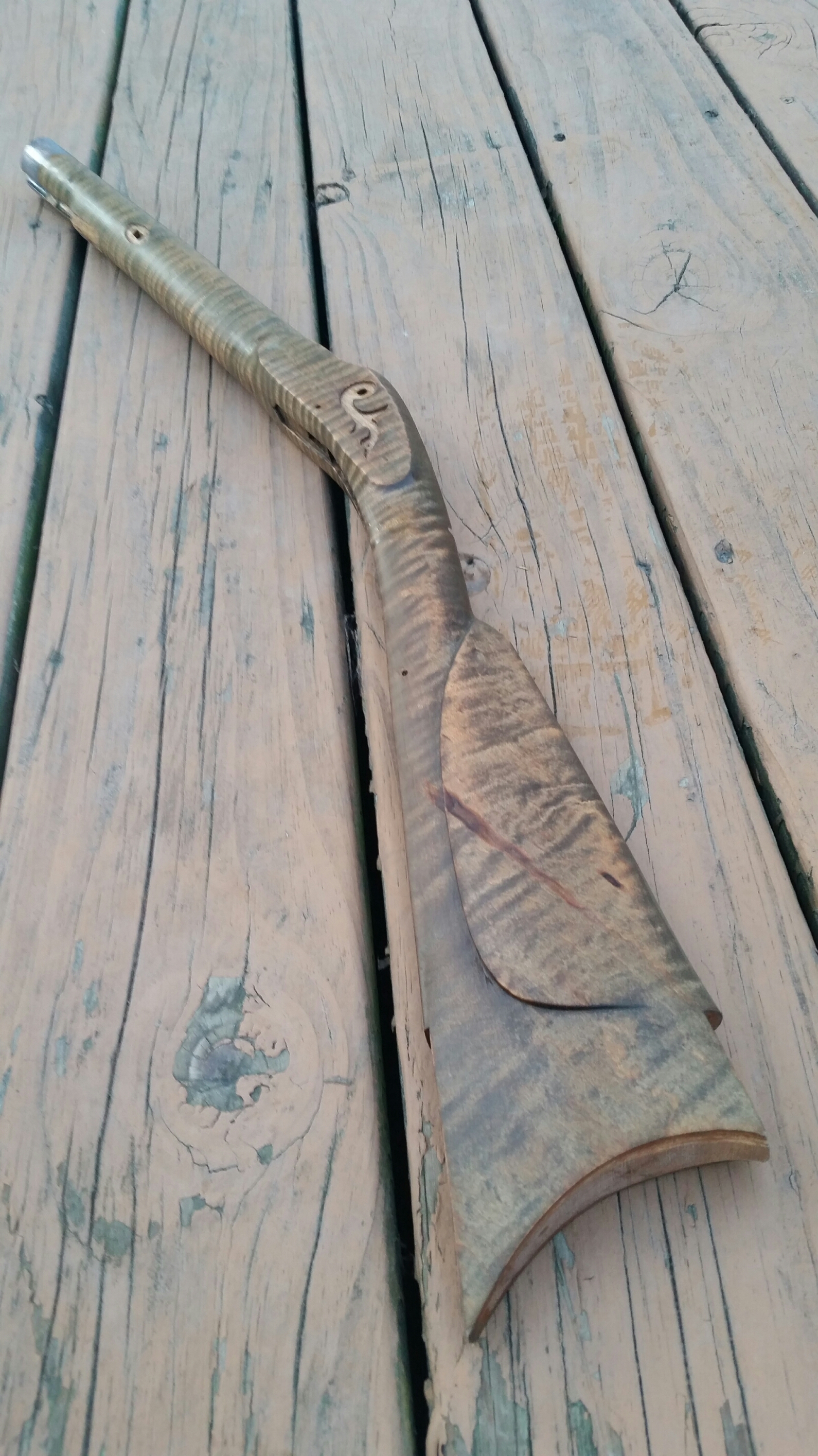
Here's a photo of the crack I'm wanting to repair.

Notice my pen point obviously points to the crack extending to the rear of the tang channel. This can be fixed in two ways upon inspection.
1. Through the lock panel and drilled up.
2. From the top left outside portion of the stock drilled down.
For me, trying to hide the repair is something I'm not concerned about, I personally believe this displays character.
Also here are a few pictures of the stock after I stripped and cleaned the wood, It was absolutely filthy! As of now the stock is hanging in a spare closet to dry. Someone along the way certainly applied something overtop of the original finish. Whatever it was age had set in and it was beginning to crack in multiple areas. I will be using BLSO followed by applications of Truoil once I've decided on a stain and that part is complete. As it sits, I personally feel the wood is beautiful.


Got to say that's what I would be doing with the gun. I think they built em to be used :thumbsup:
I agree 100% with you sir. She'll be well taken care of but will certainly see use from time to time.
galamb
58 Cal.
Here's a repair of a cracked wrist.
The crack can be seen running from the back of the lock inlet.
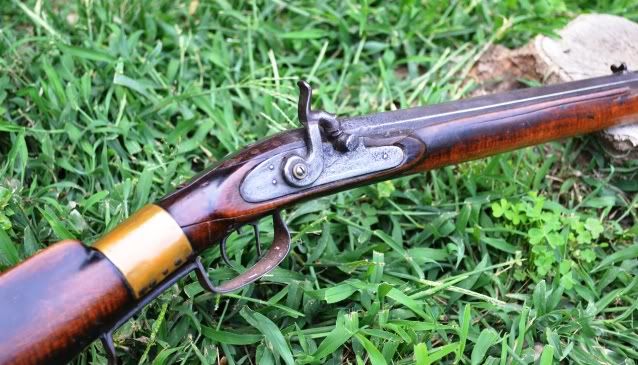
"Back When" I suggest repair were made to keep the gun useful and functional - trying to make it look either pretty or to hide the repair was probably way way down the list of repair requirements.
In the case of your crack, under the tang, I would wedge it apart and inject as much epoxy as you could. Then remove the wedge and lightly clamp crosswise until it's cured.
(epoxy is historically correct - I heard they found some in Davy Crockett's possibles bag following the scrap at the Alamo :rotf: )
More seriously, since this is a hidden part that would not be seen without removing the barrel completely, I would go with a modern fix. Since it won't be visible it would not detract at all.
The crack can be seen running from the back of the lock inlet.

"Back When" I suggest repair were made to keep the gun useful and functional - trying to make it look either pretty or to hide the repair was probably way way down the list of repair requirements.
In the case of your crack, under the tang, I would wedge it apart and inject as much epoxy as you could. Then remove the wedge and lightly clamp crosswise until it's cured.
(epoxy is historically correct - I heard they found some in Davy Crockett's possibles bag following the scrap at the Alamo :rotf: )
More seriously, since this is a hidden part that would not be seen without removing the barrel completely, I would go with a modern fix. Since it won't be visible it would not detract at all.
54ball
62 Cal.
- Joined
- Aug 23, 2004
- Messages
- 3,117
- Reaction score
- 1,018

Crewdawg said:I wanted to approach the repair in a period correct nature.
I have seen many repaired originals, some brilliantly done. Sometimes these repairs and the methods and materials used are as historically significant as the rifle itself. It all adds to the story of the rifle. Some of this is impossible to duplicate and in this case is unnecessary.
In the period that crack would have likely been ignored. If not, something hide glue may have been used to seal the crack.
IMHO that damage does not need a wrap or "pins".
As Galamb says it's under the barrel out of sight.
Some simple wood glue like tite bond would suffice, some epoxy or you may want to bed that small area.
Indeed something such as this would certainly need no wrap or pinning as I see now. The epoxy approach is something worth looking into, and a method I can allow to slide...  In terms of using epoxy, I would assume thinning the mixture could be a good idea. This would allow it to flow deep into the crack ensuring good coverage once the thinner evaporates for a strong bond. Sometimes I guess modern methods just win. :surrender:
In terms of using epoxy, I would assume thinning the mixture could be a good idea. This would allow it to flow deep into the crack ensuring good coverage once the thinner evaporates for a strong bond. Sometimes I guess modern methods just win. :surrender:
On another note, galamb I must say that is one beautiful rifle you have there! :thumbsup:
On another note, galamb I must say that is one beautiful rifle you have there! :thumbsup:
- Joined
- Jan 9, 2008
- Messages
- 1,893
- Reaction score
- 2,092
If you thin the epoxy, you can use air pressure to force the epoxy deep into the crack. Then wrap tightly with rubber. I have an old bicycle innertube that was cut apart, lengthwise as well as across. Hint Hint...remove the air valve first before wrapping :wink:
The repair by galamb looks similar to the way I did my stock.
The repair by galamb looks similar to the way I did my stock.
Not trying to be offensive
The worst thing to hear is when someone says they tried to fix it themselves.
You have already gone too far.
I am surprised your smith did not try to stop you.
If he does “fantastic work” have him do it.
If it was a piece of junk modern reproduction then go ahead, but it’s not.
Again, I am not trying to be offensive, I am giving my best advice.
Whatever you do good luck to you.
William Alexander
The worst thing to hear is when someone says they tried to fix it themselves.
You have already gone too far.
“my good friend who is a smith by trade and who does fantastic work“
I am surprised your smith did not try to stop you.
If he does “fantastic work” have him do it.
If it was a piece of junk modern reproduction then go ahead, but it’s not.
Again, I am not trying to be offensive, I am giving my best advice.
Whatever you do good luck to you.
William Alexander
Your opinion is valid, however with respects, you don't know my skills nor his. Please no offense but my rifles are tools and will certainly be uses as such for the purposes they were built for. :hatsoff:
Canute Rex
40 Cal.
- Joined
- Apr 19, 2012
- Messages
- 387
- Reaction score
- 266
Similar threads
- Replies
- 18
- Views
- 815
- Replies
- 33
- Views
- 6K
- Replies
- 7
- Views
- 1K
- Replies
- 43
- Views
- 4K



